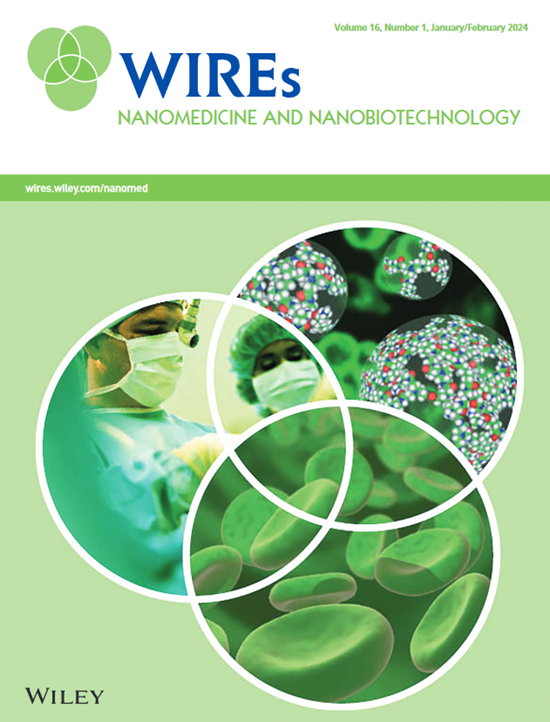新兴的纳米颗粒设计对抗细菌感染。
IF 8.2
2区 医学
Q1 MEDICINE, RESEARCH & EXPERIMENTAL
Wiley interdisciplinary reviews. Nanomedicine and nanobiotechnology
Pub Date : 2023-07-01
DOI:10.1002/wnan.1881
引用次数: 1
摘要
抗生素耐药性的上升导致预防和治疗细菌感染的效果下降。因此,研究人员转向纳米医学寻找新的有效的抗菌治疗方法。这一努力产生了第一代抗菌纳米颗粒,其特点是能够改善药物耐受性、循环半衰期和疗效。为了开发下一代抗菌纳米颗粒,研究人员整合了强调物理、广谱、仿生和抗毒机制的设计元素。这篇综述重点介绍了四种新兴的抗菌纳米颗粒设计:无机抗菌纳米颗粒、反应性抗菌纳米载体、毒力纳米清除剂和抗毒力纳米疫苗。在每个设计类别的例子选择和审查,并讨论他们的结构-功能关系。这些新兴的设计为非传统的抗菌纳米药物打开了大门,这些药物依赖于机械杀菌、功能驱动、自然启发或毒力靶向机制来克服抗生素耐药性,从而实现更有效的抗菌治疗。本文分类为:治疗方法与药物发现>传染病纳米医学。本文章由计算机程序翻译,如有差异,请以英文原文为准。

Emerging nanoparticle designs against bacterial infections.
The rise of antibiotic resistance has caused the prevention and treatment of bacterial infections to be less effective. Therefore, researchers turn to nanomedicine for novel and effective antibacterial therapeutics. The effort resulted in the first-generation antibacterial nanoparticles featuring the ability to improve drug tolerability, circulation half-life, and efficacy. Toward developing the next-generation antibacterial nanoparticles, researchers have integrated design elements that emphasize physical, broad-spectrum, biomimetic, and antivirulence mechanisms. This review highlights four emerging antibacterial nanoparticle designs: inorganic antibacterial nanoparticles, responsive antibacterial nanocarriers, virulence nanoscavengers, and antivirulence nanovaccines. Examples in each design category are selected and reviewed, and their structure-function relationships are discussed. These emerging designs open the door to nontraditional antibacterial nanomedicines that rely on mechano-bactericidal, function-driven, nature-inspired, or virulence-targeting mechanisms to overcome antibiotic resistance for more effective antibacterial therapy. This article is categorized under: Therapeutic Approaches and Drug Discovery > Nanomedicine for Infectious Disease.
求助全文
通过发布文献求助,成功后即可免费获取论文全文。
去求助
来源期刊

Wiley interdisciplinary reviews. Nanomedicine and nanobiotechnology
NANOSCIENCE & NANOTECHNOLOGY-MEDICINE, RESEARCH & EXPERIMENTAL
CiteScore
16.60
自引率
2.30%
发文量
93
期刊介绍:
Nanotechnology stands as one of the pivotal scientific domains of the twenty-first century, recognized universally for its transformative potential. Within the biomedical realm, nanotechnology finds crucial applications in nanobiotechnology and nanomedicine, highlighted as one of seven emerging research areas under the NIH Roadmap for Medical Research. The advancement of this field hinges upon collaborative efforts across diverse disciplines, including clinicians, biomedical engineers, materials scientists, applied physicists, and toxicologists.
Recognizing the imperative for a high-caliber interdisciplinary review platform, WIREs Nanomedicine and Nanobiotechnology emerges to fulfill this critical need. Our topical coverage spans a wide spectrum, encompassing areas such as toxicology and regulatory issues, implantable materials and surgical technologies, diagnostic tools, nanotechnology approaches to biology, therapeutic approaches and drug discovery, and biology-inspired nanomaterials. Join us in exploring the frontiers of nanotechnology and its profound impact on biomedical research and healthcare.
 求助内容:
求助内容: 应助结果提醒方式:
应助结果提醒方式:


